Content available at: Español (Spanish)
High temperature periods often generate a high relative humidity. This usually happens during the summer months. Heat stress can deeply affect the productivity of a flock.
At ambient temperatures of over 33° C (91.4 °F), high mortality and great loss of production are apparent, though at less extreme temperatures we often overlook heat stress as a cause for poor growth or loss of egg production, as well as a lower eggshell quality.
Thermoregulation in poultry
The excess body heat is removed via four different mechanisms:
Convection
Loss of body heat through cold circulating air. Fowls enlarge the exposed surface area by lowering and extending their wings away from their bodies. Convection is aided by air movement, thus creating a cold air effect
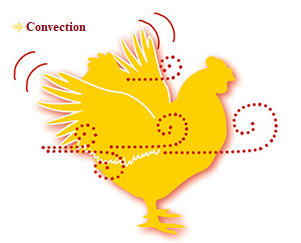
Vasodilation
Blood swells wattles and combs, sending the core body heat to the surface, which is then lost to the surrounding air.
Radiation.
Electromagnetic waves transfer heat via the air to a distant object. Body heat is irradiated to colder objects in the barn (for example, the walls, the ceiling, or the equipment).

Evaporative cooling.
Fast, shallow breathing with mouth open increases loss of body heat by increasing evaporation of water in the mouth and the respiratory tract. Decrease of moisture in the air contributes to evaporative cooling.
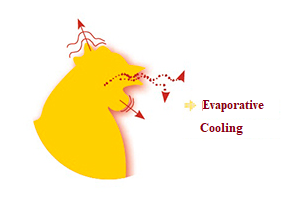
Conduction.
Loss of body heat to colder objects in direct contact with fowls (for example, the litter, roost floor, cage wire). Fowls look for the coolest areas in the shed. Fowls lie on the floor or dig into the litter to find a cooler place.
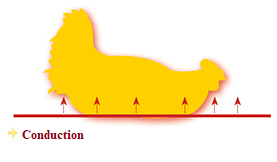
Radiation, convection, and conduction together are known as sensible heat loss.
The thermoneutral zone in the fowl is generally between 18– 25°C. Within this temperature range, loss of sensible heat is suitable to maintain the normal temperature of the fowl at 41°C.
Above the thermoneutral zone, the efficiency of sensible heat loss mechanisms is diminished. At this point, water evaporation from the respiratory tract becomes the main heat loss mechanism in the fowl. The evaporation of one gram of water dissipates 450 calories of body heat.
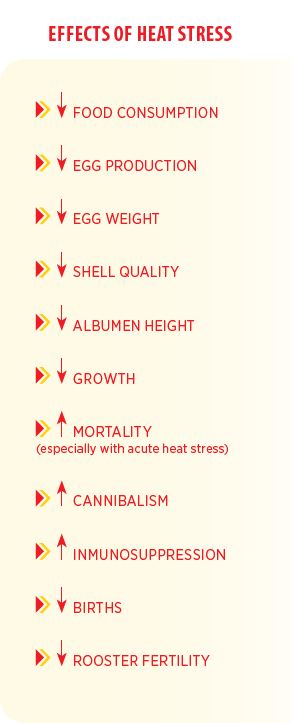
At temperatures higher than the thermoneutral zone, the fowl uses its energy to maintain a normal body temperature and its metabolic activities. This takes energy from growth and egg production, resulting in a lower yield.
At high ambient temperatures, fowls start breathing with mouth open in a fast, shallow manner known as gular reflux, to increase water evaporation from the respiratory tract. When panting fails to maintain the body temperature, the fowl becomes lethargic, comatose, and can even die.
The broods that have not been previously acclimated to high temperatures usually suffer the greatest productivity losses and mortality.
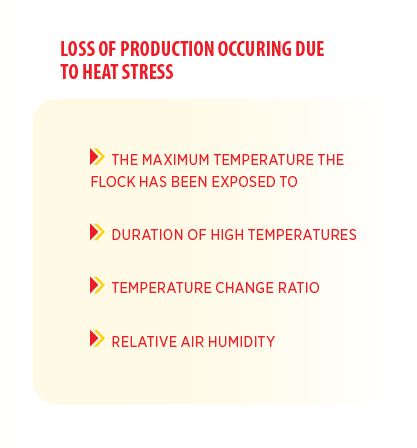
Younger fowls who have been exposed to high ambient temperatures are thermically more tolerant later on in life, due to the production of heat shock proteins.
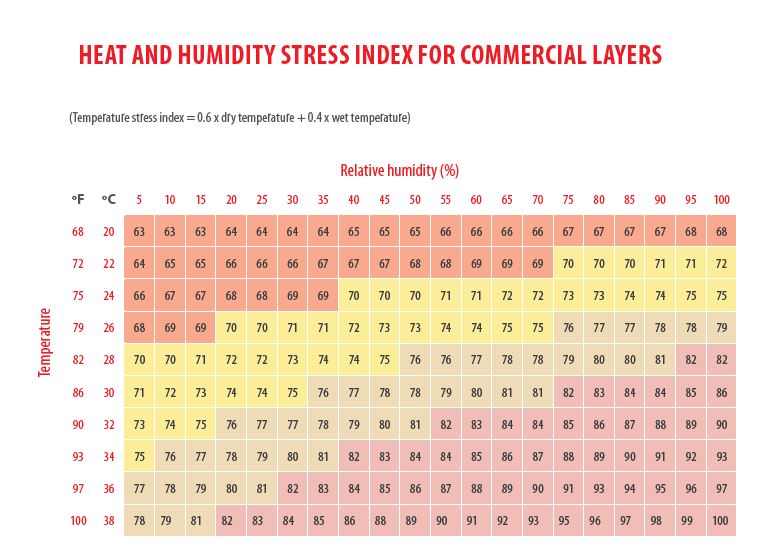
Figure 2. Adaptation of heat stress index combining the effects of temperature and humidity for layers. Xin, Hongwei, and Harmon, Jay D., “Livestock Industry Facilities and Environment: Heat Stress Indices for Livestock” (1998) Agriculture and Environment Extension Publications. Book 163, Iowa State University
Fowl’s Comfort Zone (heat index <70)
No action is required; it is the right time to prepare for a future warm season.
Alera (heat index 70–75)
Start taking action to reduce heat stress in the brood; increase ventilation; increase fan speed and use misters (misters can work based on the relative humidity). Monitor the fowls’ behavior for any sign of heat stress; make sure drinker and ventilation systems are working right.
Danger (heat index 76-81)
Heat stress conditions are present; take immediate action to reduce heat stress in the Flock; increase ventilation in closed barns and use relative humidity- based evaporation pads; in open sheds, turn on fans and misters. Adjust nutrient density in the diet to make up for any drop in food consumption. Move the air over the fowls at a maximum speed of 1.8–2.0 meters per second. Periodically purge water lines with cold water. Closely monitor the brood behavior. Maximize cooling at night.
Emergency (heat index > 81)
Extreme heat stress conditions are present; avoid handling fowls for transport and vaccination. Do not feed them during hot hours of the day. Lower light intensity to reduce activity and heat generation in the fowls.
“When temperatures are high, fowls start to breathe in a fast and shallow manner, with mouth open”
Ambient temperature to relative humidity Ratio
The effective temperature is obtained through the combination of air temperature and relative humidity. Depending on how these parameters are inter-related, a heat stress condition can arise.
A rise of moisture in the air at any temperature will increase discomfort and heat stress in the chicken.
Farmers must closely monitor the temperature and humidity in their facilities.
Generally, during the day, the temperature rises and relative humidity drops. The best cooling method during low humidity periods is by evaporative cooling (mister, sprayer, or moist pad).
In the afternoon, when temperature drops, and humidity typically rises, the use of misters to enhance humidity can increase heat stress. When humidity is high, use only fans to speed up air circulation and reduce heat stress in open sided barns.
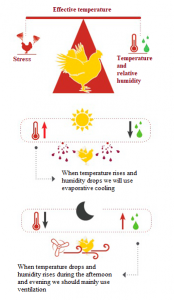
Air movement creates a cold air effect, and the body senses a temperature drop due to the air Flow. A heat stress index table has been developed for commercial layers. (Figure 2)
“Flocks that have not been previously acclimated to high temperatures are the ones with the greatest loss of productivity and mortality “
Effect of heat stress on the eggshell quality
The flocks of layers under heat stress often lay eggs having thinner and weaker eggshells due to an acid/base disturbance which takes place in the blood as a result of panting (hyperventilation, gular reflux).
When birds hyperventilate to shed body heat, there is an excessive loss of CO2 gas in the lungs and blood. Decrease of CO2 gas in the blood causes the blood pH to rise or become more alkaline. This condition is known as respiratory alkalosis.
Increasing the level of blood pH decreases the activity of the enzyme carbonic anhydrase, which results in a reduction of calcium and carbonate ions transferred from the blood to the Shell gland (uterus). Increasing diet calcium will not correct this problem.
Another contributing factor to thin eggshell is the decrease in calcium consumption as a result of reducing food consumption and escalating loss of phosphorus.
Restoring the acid/base balance

Potassium chloride, ammonium chloride, or sodium bicarbonate (2–3 kg/MT of feed) can replace the lost electrolytes during heat stress and promote water consumption. It has been shown that these treatments are useful to reduce mortality in flocks affected by acute heat stress.
Management of the drinker system for a flock affected by heat stress
During high ambient temperature times, the flock has high water consumption requirements. The water – food consumption ratio is normally from 2:1 at 21°C, but it is increased to 8:1 at 38°C.
- For flocks affected by heat stress there must be as much available drinking water as needed.
- Make sure drinkers have a suitable water flow (> 70 ml/minute/ nipple drinker).
- Make sure drinkers work correctly and provide enough space.
- For flocks bred on the floor, providing additional drinkers might help balance the water consumption increase.
- Fresh water can help reduce the birds’ core temperature, and hence reduce the impact of heat stress.
- Purging water lines in the afternoon helps cool water down and this has been shown to enhance food consumption and sustain egg production in a lot of layers affected by heat stress.
- Plastic lines are quickly heated by ambient temperature, making it difficult to cool water below the air temperature, particularly near the ends of long water lines.
- Keeping water at a temperature below 25°C helps maintain a greater water consumption, thus causing a greater food consumption. A water temperature above 30°C will have a negative impact on water consumption, and it will also adversely affect food consumption.
- Use vitamins and electrolyte supplements in drinking water to compensate the loss of sodium, chloride, potassium, and bicarbonate in urine. Supplementary electrolytes work best when they are used before a sudden rise of ambient temperature.
- Drinking water is heated when tanks are directly exposed to sunlight. Such tanks must be light colored, be insulated, and be covered to avoid direct exposure to sunlight. Ideal water tanks are those placed within the barns, or those installed underground.
“Heat stress-affected layer flocks lay eggs with thinner and weaker eggshells due to the blood acid/base balance disturbance as a result of panting “
Management of a flock affected by heat stress
- Do not disturb the chickens during the hottest hours of the day or early evening). Adapt work schedules and lighting schedules such that the routine chores are performed early morning or at night.
- Management practices which require handling the fowls, such as beak trimming, transport, and vaccinations (via a drop into the eye, the wing surface, or by injection), should not be performed early morning.
- Use misters and vaporizers to enhance evaporative cooling during the day. Turn on the misters for 2 minutes every 10 minutes. Misting schedules must be adjusted based on the temperature and humidity within the barn.
- Misting at the air inlets of negative pressure ventilation systems has a suitable cooling effect.
- Using ceiling sprayers during extremely high temperatures can remove heat from the ceiling and cool the barn inside.
- Adjust thermostats such that fans work throughout the night and early morning. The purpose of this is maximizing the cooling inside the barn during the night and prolong the mild temperature period until the next morning.
- Increase air circulation in open barns by means of fans. Assure a speed of 1.8–2.0 meters/second where the chickens are.
- Caged in birds are more susceptible to heat stress because they are unable to look for a cooler area, and inside the cages they have a lesser chance of shedding heat by conduction. The temperature inside the cage can be much higher than the ambient temperature measured along the aisles. An increase of air speed among cages enhances los of heat by conduction and removes the air entrapped among the birds

- Do not work feeders during the hottest time of day.
- Avoid having too many cages; cages containing too many birds prevent air from flowing among the birds, thus diminishing the performance of ventilation and increasing the heat load in the barn.
- Transport birds early morning or at night. Place fewer birds in each crrier case and keep empty cases in the truck to make room for ventilation around the birds during transport.
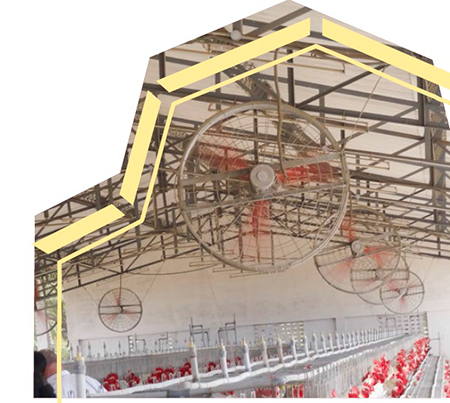
- For more information, see Hy-Line International management guidelines
Acknowledgements: Dr. Hongwei Xin, professor, Department
- Agradecimientos: al Dr. Hongwei Xin, profesor del Departament













